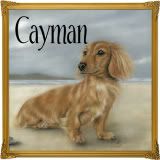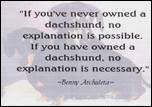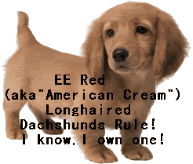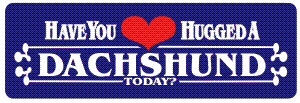
 Therapy dogs spread happiness, love, and cheer to people who otherwise might be lonely, sad or slow to heal. This is the journey of Cayman, a longhair miniature dachshund and his journey and experiences visiting becoming a therapy dog.
Therapy dogs spread happiness, love, and cheer to people who otherwise might be lonely, sad or slow to heal. This is the journey of Cayman, a longhair miniature dachshund and his journey and experiences visiting becoming a therapy dog.
Did you know that pet visits often spark good memories of a person's own pets? Dogs often can reach people and children who have withdrawn from the world. It's been suggested by science that petting a dog can lower blood pressure, reduce anxiety and stress, and promote healing.


Loyal Followers
Thursday, October 9, 2008
A Fancy Name for a Not So Fancy Dog
So far we have:
"GCK's Wittleman and the Sea" or "GCK's Wittleman 'N the Sea"
We are just waiting to hear back from some more experienced dachshund breeders that have registered their dogs with the AKC already. I basically need to know if using the words "and" and "the" are appropriate in a registered name. And in case you were wondering, GCK stands for the breeder's information which is Gentry's Celtic Kennels.
We Still Need Your Votes!
http://www.carealotpets.com/
Sunday, October 5, 2008
Thursday, October 2, 2008
Vote for Cayman Daily!!!
Here’s all you have to do….click the link and enter my ID number when you get there. Then cross your fingers that he wins! Winner gets a $25 gift card! Its one vote per day so mark the page as a favorite and come back often!
http://www.carealotpets.com/
Enter ID# 1349
Bummer, No Tax Break for Therapy Dogs
My Question:
I understand that certain aspects of owning a service dog are tax deductable- but what about therapy dogs?
There are no deductions or tax breaks of any kind for owning a therapy dog.
Some of the expenses of some types of service dog can be deducted as unreimbursed medical expense. Service animals are considered "durable medical assistive devices," the same as a wheel chair or walker and that's what makes their training and maintenance a medical expense. The IRS does not recognize all types of service dogs, including owner-trained dogs without documentation, and medical alert/response dogs.
A therapy dog used for visiting hospitals and nursing homes would not be medical equipment for you, so it would not qualify for such a deduction.
I doubt the therapy organization you are with gets a tax deduction. They probably get a tax exemption (to make purchases without paying sales tax), not from being a therapy dog group, but from being a 501(c)3 public charity.
There's a lot of confusion among the public between therapy dogs and service dogs. They are two entirely different things. Many dogs have jobs (therapy dogs, police dogs, search and rescue dogs, hunting dogs, etc.). Only service dogs are addressed under federal and state disability laws, such as the Americans with Disabilities Act. Service dogs may accompany their disabled handler to places where pet dogs are not permitted. Therapy dogs cannot. Service dogs are granted an exception to stay in rental housing and in hotels that do not permit pets and are exempted from deposits and pet fees, because they are medical devices, not pets.
Legally therapy dogs are considered pets. They have no more rights than pets do and their owners have no more rights than other pet owners. Therapy dog certification shows facilities such as hospitals and nursing homes that the dog has received certain training, temperament evaluations, health screening and has liability insurance. It is not a guarantee that the therapy dog can enter any hospital the owner chooses. They may enter only with permission from the hospital administration. The reasons for getting certified are to get that liability insurance and to get documentation to use in convincing the hospital to let you visit their facility.
Wednesday, October 1, 2008
Rally-O: Brief Description
 "What in the world is that?!" someone asked me at a recent show and pointed to the ring where stewards were setting up ground-level signs. I answered simply, "rally obedience," and explained the strange goings-on in the ring.
"What in the world is that?!" someone asked me at a recent show and pointed to the ring where stewards were setting up ground-level signs. I answered simply, "rally obedience," and explained the strange goings-on in the ring.
Rally obedience, or "Rally-O" as it has been termed by enthusiasts, is the latest American Kennel Club event to hit the show circuit. Rally-O combines characteristics of sports car racing, dog agility, and traditional obedience into a new fun sport.
Rally is timed, includes 12-20 performance stations depending on the level of participation, and is scored by a judge who watches for a smooth performance as well as skill in following the directions at each station.
As it does with obedience and agility, AKC offers Rally titles at three levels:
- Novice, with on-leash exercises that demonstrate the dog's understanding of basic commands such as sit, stay, down, and come and heel position;
- Advanced, a set of exercises performed off-leash that includes at least one jump; and
- Excellent, a more difficult off-leash course that includes at least one jump and demonstrates more precise skill and coordination between the dog and handler.
As in agility, courses are designed by the judge and are different in every trial. Exhibitors receive a course map from the judge and can walk the course without their dogs prior to the start of the class. Judges design their courses by choosing from more than four dozen stations that direct handlers and dogs to perform specific exercises.
A sign at each station gives instructions to the dog-handler team, and each team must execute the station's particular task within two-to-four feet of the sign. Once the judge gives the command "forward," the dog and handler complete the course on their own without further commands from the judge. Handlers may not use treats or toys in the ring, but may do anything else to encourage their dogs at the novice and advanced levels except physically touch them or make corrections with the leash. Encouragement is allowed at the excellent level but handlers cannot pat their legs or clap their hands as they can in novice and advanced classes.
Signs instruct teams to go fast or slow, to halt (dog must sit at heel), to make turns and circles, to reverse direction, to do a sit-stay-recall, or to follow other basic obedience exercises.
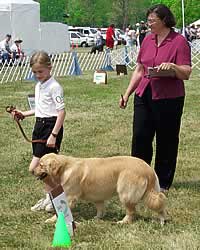 Each team has a starting score of 100 points from which points are deducted for such faults as missed or incompletely performed stations, touching the dog, leash corrections, etc. The team with the highest score (i.e., fewest number of faults) wins first place, followed by the next highest score for second place, and so forth.
Each team has a starting score of 100 points from which points are deducted for such faults as missed or incompletely performed stations, touching the dog, leash corrections, etc. The team with the highest score (i.e., fewest number of faults) wins first place, followed by the next highest score for second place, and so forth.
If two teams achieve the same score, the judge determines the placements according to the time recorded for each team's course completion.
Rally-O is a wonderful introduction to the sport of obedience for dogs and owners, an end it itself, an opportunity for veteran dogs to remain active, and a chance for shy or anti-social dogs to get ring experience without worrying about being examined by a judge.
Many dogs enjoy this change from the usual silent heeling of traditional obedience as their handlers can clap hands, talk, whistle (even sing!) to them throughout the entire course without penalty. Those who participate in agility trials will recognize the pre-class "walk-throughs" and the challenge of working with their dog partners in an almost dance-like flow from one station to another. A complete description of Rally Obedience is on the AKC website at http://www.akc.org/pdfs/rulebooks/RO2999.pdf. Station signs for all three levels can be found http://www.akc.org/pdfs/rulebooks/ROR999.pdf. Information is also available at dog clubs that are sponsoring demonstrations and classes for an increasing number of dog owners who are happily exclaiming "Rally-O!"
Soft Claws, Rally and New Obedience Classes
I found the coolest thing online. I have seen these Soft Claws in the past but never really thought about how beneficial they would be, especially for a therapy dog. They are these soft caps that are glues onto a dog (or cat's) nail to dull the sharp edges to protect floors, people, doors, and even from scratching themselves (think hotspots or itchy skin that is irritated already). When you have a therapy dog, they are expected to be well behaved and not jump on people but you always worry in the back of your mind that one day, your dog is going to scratch the patient and that does not make for a pleasurable experience, one of the main reasons for having the dog visit the patient in the first place. I decided I would definitely get these for Cayman even before he begins his therapy work. He is still a rambunctious puppy and we are still working with him to not jump on people, especially on Shaylee, our two year old daughter. Even though he is not broken the skin, since me manage to keep his nails at a reasonable length, they still can leave ugly marks down your legs. So I have a rep from the company sending me a sample nail cap in black, clear and blue- the only colors I was considering (I am still unsure of the blue…) in the two sizes I think he would wear. This way I can see the product up close and try one on him. Perhaps I will even get them for the cat (who really, really needs them) and Zoey (she’d look great in the pink ones). I noticed that Petsmart carries them on their website to be ordered online so I will have to be smart and look into whether it’s more affordable to buy them at the store (if available) or order online, and if so, which website has the best deal on them.
I also discovered that certain organizations are eligible to receive tax deductions, such as some therapy dog groups. And when I searched the IRS website, I was delighted to see that Therapy Dogs Incorporated was included (strangely Delta Society was not or at least I could not find them)! So I started a spreadsheet of everything I am (have) bought for Cayman that is therapy dog related for tax purposes. So far I got my “The Canine Good Citizen- Every Dog Can Be One” book as a material item, and Cayman’s “Therapy Dog in Training” bandana listed as supplies. I may or may not be able to use them towards my tax deductions but I would rather have it all together, just in case. And if nothing else, it’s a good way to see how much I am spending to go this, since I can get a little over my head when I have my heart set on something. I think I am going to put my dog training classes on there as well (not the Petco puppy training class since that is more just dog ownership related) as well as the mileage used to get to the training classes and when he actually begins working as a therapy dog- the mileage to get to the establishments we are visiting (you can deduct the cost of driving at a rate of $.14 per mile), and of course the Soft Claws (equipment).
Speaking of dog training classes… Nils, my husband, has agreed to treat me (and Cayman of course) to dog obedience classes with our local AKC dog club- the Dog Obedience Club of Lee County (DOCLC) for Christmas. The class that we will be attending starts January 7th. It’s a 6 weeks for $60, every Wednesday night, in which he will learn the basics of obedience, a step above what he learned already at the Petco course. He is also going to attend the intermediate obedience classes which are $20 for 20 weeks of training in which he will learn a lot of what’s covered in the CGC certification tests as well as Rally. For that price, you can’t beat that! And I have seen the dog’s in action at this past weekend’s Responsible Dog Ownership Day- the dog’s are geniuses and so obedient!
And the best part of the DOCLC is that after you complete the 20 week intermediate course, you can apply for membership with DOCLC and pay only $30 a year in membership fees and get to go and train at the club as often as you like for no charge! And with what you learn in the classes, you can go on to competitions of the various dog sports and win titles and prizes! What fun!
Rally. That’s another subject I would LOVE to get Cayman into as it looks like such fun! It’s a dog sport in which the dog and handler complete a course of exercise stations. The dog and handler can complete them at their own pace and the scoring is not as rigorous as traditional obedience trials. Plus the handlers are allowed to praise, talk, and encourage their dogs. Rally is an excellent link from the CGC program to obedience or agility competitions. Plus Cayman could earn titles like Rally Novice (RN), Rally Advanced (RA), Rally Excellent (RE), and Rally Advanced Excellent (RAE)! The woman that runs the DOCLC said Cayman would be excellent at it.
Oh and I almost forgot, Zoey finally got her haircut. She looks like a real poodle now. The only problem is Cayman tends to play a little rough with her. He is so used to that big plush coat to grab onto when he plays and now its gone. She has in more than one occasion got nipped a bit too hard when playing, so we are working on that. Cayman is at that bratty stage where he torments the other dogs to constantly play with him.






